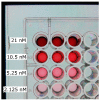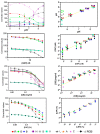The Efficiency of Color Space Channels to Quantify Color and Color Intensity Change in Liquids, pH Strips, and Lateral Flow Assays with Smartphones
- PMID: 31766483
- PMCID: PMC6928750
- DOI: 10.3390/s19235104
The Efficiency of Color Space Channels to Quantify Color and Color Intensity Change in Liquids, pH Strips, and Lateral Flow Assays with Smartphones
Abstract
Bottom-up, end-user based feed, and food analysis through smartphone quantification of lateral flow assays (LFA) has the potential to cause a paradigm shift in testing capabilities. However, most developed devices do not test the presence of and implications of inter-phone variation. Much discussion remains regarding optimum color space for smartphone colorimetric analyses and, an in-depth comparison of color space performance is missing. Moreover, a light-shielding box is often used to avoid variations caused by background illumination while the use of such a bulky add-on may be avoidable through image background correction. Here, quantification performance of individual channels of RGB, HSV, and LAB color space and ΔRGB was determined for color and color intensity variation using pH strips, filter paper with dropped nanoparticles, and colored solutions. LAB and HSV color space channels never outperformed the best RGB channels in any test. Background correction avoided measurement variation if no direct sunlight was used and functioned more efficiently outside a light-shielding box (prediction errors < 5%/35% for color/color intensity change). The system was validated using various phones for quantification of major allergens (i.e., gluten in buffer, bovine milk in goat milk and goat cheese), and, pH in soil extracts with commercial pH strips and LFA. Inter-phone variation was significant for LFA quantification but low using pH strips (prediction errors < 10% for all six phones compared). Thus, assays based on color change hold the strongest promise for end-user adapted smartphone diagnostics.
Keywords: allergens; background correction; color space; food contaminant screening; image correction; lateral flow assay quantification; point of site analyses; smartphone colorimetrics.
Conflict of interest statement
The authors declare no conflict of interest. The funders had no role in the design of the study; in the collection, analyses, or interpretation of data; in the writing of the manuscript, or in the decision to publish the results.
Figures












Similar articles
-
A Randomized Combined Channel Approach for the Quantification of Color- and Intensity-Based Assays with Smartphones.Anal Chem. 2020 Jun 2;92(11):7852-7860. doi: 10.1021/acs.analchem.0c01099. Epub 2020 May 21. Anal Chem. 2020. PMID: 32383383
-
Smartphone-based colorimetric analysis for detection of saliva alcohol concentration.Appl Opt. 2015 Nov 1;54(31):9183-9. doi: 10.1364/AO.54.009183. Appl Opt. 2015. PMID: 26560572
-
Secure Food-Allergen Determination by Combining Smartphone-Based Raw Image Analyses and Liquid Chromatography-Mass Spectrometry for the Quantification of Proteins Contained in Lateral Flow Assays.Anal Chem. 2022 Dec 13;94(49):17046-17054. doi: 10.1021/acs.analchem.2c03000. Epub 2022 Nov 29. Anal Chem. 2022. PMID: 36445804 Free PMC article.
-
Lateral and Vertical Flow Assays for Point-of-Care Diagnostics.Adv Healthc Mater. 2019 Jul;8(14):e1900244. doi: 10.1002/adhm.201900244. Epub 2019 May 13. Adv Healthc Mater. 2019. PMID: 31081270 Review.
-
Review of measures for light-source color rendition and considerations for a two-measure system for characterizing color rendition.Opt Express. 2013 Apr 22;21(8):10393-411. doi: 10.1364/OE.21.010393. Opt Express. 2013. PMID: 23609750 Review.
Cited by
-
Positively Charged Organosilanes Covalently Linked to the Silica Network as Modulating Tools for the Salinity Correction of pH Values Obtained with Colorimetric Sensor Arrays (CSAs).Sensors (Basel). 2024 Jan 10;24(2):417. doi: 10.3390/s24020417. Sensors (Basel). 2024. PMID: 38257510 Free PMC article.
-
A Microfluidic Paper-Based Analytical Device for Type-II Pyrethroid Targets in an Environmental Water Sample.Sensors (Basel). 2020 Jul 23;20(15):4107. doi: 10.3390/s20154107. Sensors (Basel). 2020. PMID: 32718040 Free PMC article.
-
Optical Screening Methods for Pesticide Residue Detection in Food Matrices: Advances and Emerging Analytical Trends.Foods. 2021 Jan 5;10(1):88. doi: 10.3390/foods10010088. Foods. 2021. PMID: 33466242 Free PMC article. Review.
-
Smartphone-based optical assays in the food safety field.Trends Analyt Chem. 2020 Aug;129:115934. doi: 10.1016/j.trac.2020.115934. Trends Analyt Chem. 2020. PMID: 32904649 Free PMC article. Review.
-
Six decades of lateral flow immunoassay: from determining metabolic markers to diagnosing COVID-19.AIMS Microbiol. 2020 Aug 26;6(3):280-304. doi: 10.3934/microbiol.2020018. eCollection 2020. AIMS Microbiol. 2020. PMID: 33134745 Free PMC article. Review.
References
-
- The Rapid Alert System for Food and Feed (2017 Annual Report) [(accessed on 20 November 2019)]; Available online: https://ec.europa.eu/food/sites/food/files/safety/docs/rasff_annual_repo....
-
- Sivadasan S., Efstathiou J., Calinescu A., Huatuco L.H. Advances on measuring the operational complexity of supplier-customer systems. Eur. J. Oper. Res. 2006;171:208–226. doi: 10.1016/j.ejor.2004.08.032. - DOI
-
- Knowles T., Moody R., McEachern M. European food scares and their impact on EU food policy. Br. Food J. 2007;109:43–67. doi: 10.1108/00070700710718507. - DOI
MeSH terms
Substances
Grants and funding
LinkOut - more resources
Full Text Sources
Miscellaneous

